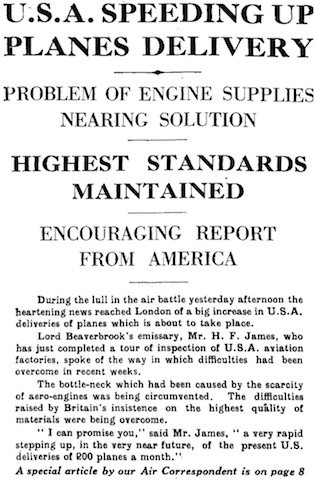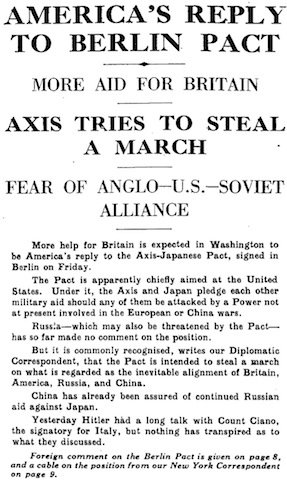
The big headlines of the day in today’s Observer aren’t about warfighting at all, whether it’s overhead or overseas. Perhaps this is because of the ‘lull in the air battle yesterday’ (7), or maybe reporting raid after air-raid is getting monotonous. But as with the last time this happened, the news is that the United States is sending more aid to Britain. Or at least it is promising ‘a very rapid stepping up, in the very near future’ of aircraft deliveries to Britain, currently running at 200 machines a month. This is due to ‘the complete recovery of American faith in British chances against Nazi Germany’:
For instance, the British are now being “cut in” on future production of the huge Flying Fortress type of American bomber. The showing made by the much-praised R.A.F. furnishes the grounds for this step adopted by the army authorities
Hitherto these authorities, recalling how American planes destined for France had fallen by the hundreds into Nazi hands, were reluctant to make any concession. Moreover, it is now felt that Britain’s stern resistance is giving the United States the needed time to perfect its own defences.
But a separate article on this page reports from Burbank, California that ‘The new twin-engined Lockheed P-38 interceptor plane’ has been undergoing flight tests. It is expected to be capable of ‘500 miles an hour’ (with a rate of climb of 4000 feet per minute), but Britain will not be able to order it. Instead it is getting a down-rated export variant which can only do ‘over 400 miles an hour’. So American support for Britain is not quite unqualified.
There is of course news of the air war:
After the night’s two raids, which were again mainly directed against London, and which damaged a famous church in the South-West, wrecked a whole street, and hit a school, German bombers crossed the coast in the South-East and South-West yesterday.
It’s not that long ago that reports of the day’s action would involve massed dogfights and dozens of aircraft being shot down. Now combat is at a much lower intensity:
News soon came of the destruction of a bomber, which was apparently crippled by A.A. fire and then finished off at East Horsley by a fighter.
And now the drama is mostly on the ground:
South London area suffered heavily from incendiary bombs. In one district the number of separate fires ran into double figures, and the concerted glare was seen over a wide area.
No sooner was any one of the fires brought under control than another sprang up in its place, only to be immediately attached by more firemen. Thick black clouds weaved themselves into shapes that only Disney could have devised.
In this case, the fire brigades worked very fast and ‘the fires were got under control in an amazingly short space of time’:
When the Nazis returned not a glimmer of light from the fires was left to guide them.
The Observer‘s air correspondent, Major Oliver Stewart (interestingly, neither the military nor the naval correspondent, who both have articles appearing today, are named) opens his article confidently (8):
Evidence is now accumulating that the Royal Air Force is now well on the way to gaining air supremacy in the European theatre. It comes from the only source in which it is possible to place complete confidence, namely, the constantly changing reactions of the German air force.
But Stewart’s ending is less reassuring, despite his best efforts:
It would be a mistake to assume, however, that this big rate of loss has crippled the German service. It can recover quickly, and only takes a day or two to re-form its units. Reserves are likely still to be sufficient to enable further big efforts to be made.
A possible future move is a brief lull and then an assault on a far bigger scale than anything hitherto. Such an attempt would carry big risks for the Germans; but they never hesitate from taking such risks. If such an assault were made and really punished by the R.A.F., air supremacy would be ours.
By way of a ‘neutral correspondent’ comes a new report of a German ‘hitherto “secret weapon”‘, one ‘with which Goering hoped to crush Britain with his Air Force, despite bad weather conditions. It is called ‘Cloud-Roentgen‘:
by means of a small apparatus like a miniature television set next to the pilot’s seat, the pilot was enabled to see through the clouds or fog.
The only way to tell from outside the aeroplane that Cloud-Roentgen is installed ‘is that the nose is painted with specially-prepared chemical solutions and serves as a lens for the television apparatus’. Compare this with the infrared searchlights which were reported a couple of weeks ago.
![]() This work is licensed under a Creative Commons Attribution-NonCommercial-NoDerivatives 4.0 International License.
Permissions beyond the scope of this license may be available at http://airminded.org/copyright/.
This work is licensed under a Creative Commons Attribution-NonCommercial-NoDerivatives 4.0 International License.
Permissions beyond the scope of this license may be available at http://airminded.org/copyright/.






Pingback: Airminded · Friday, 27 September 1940